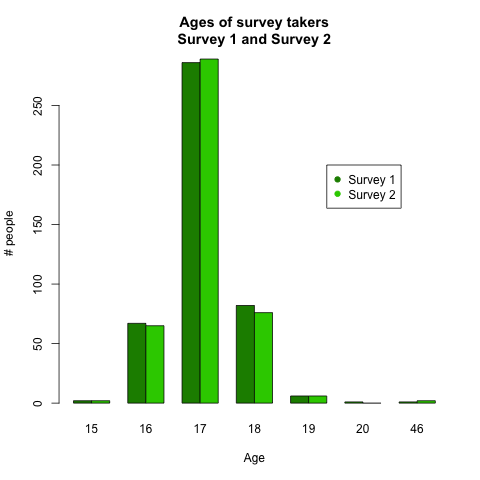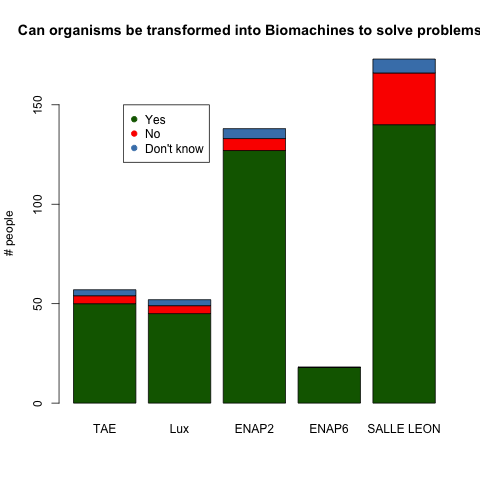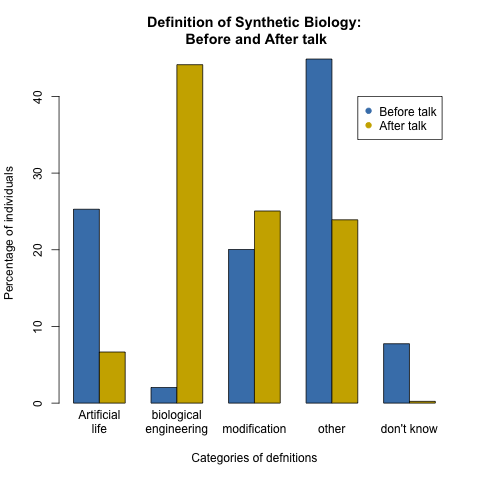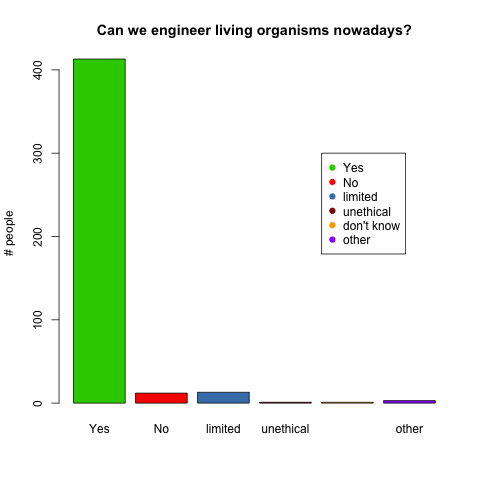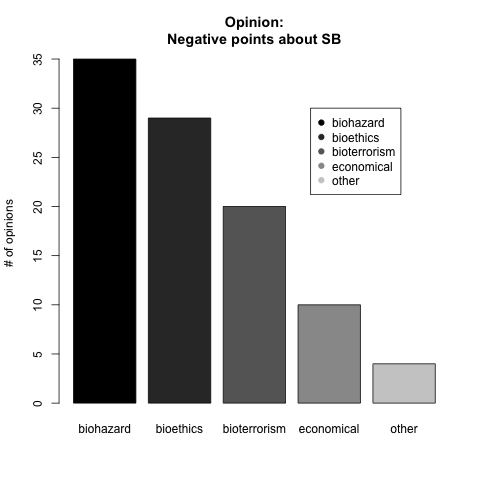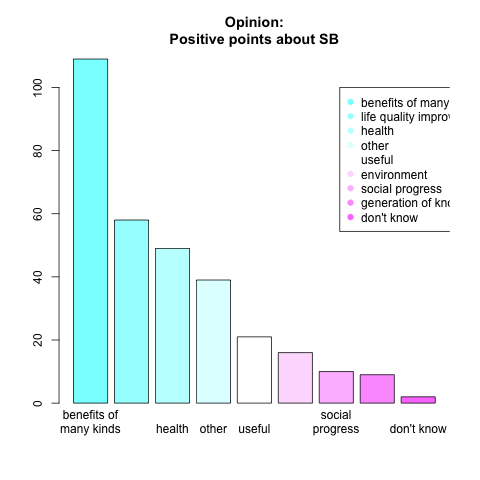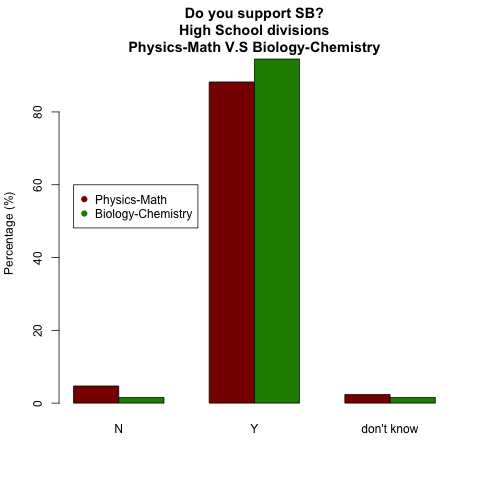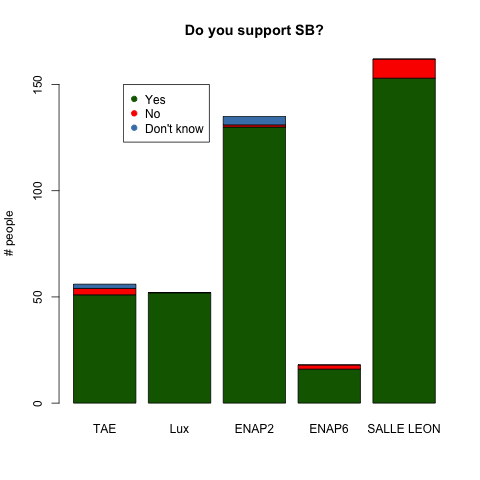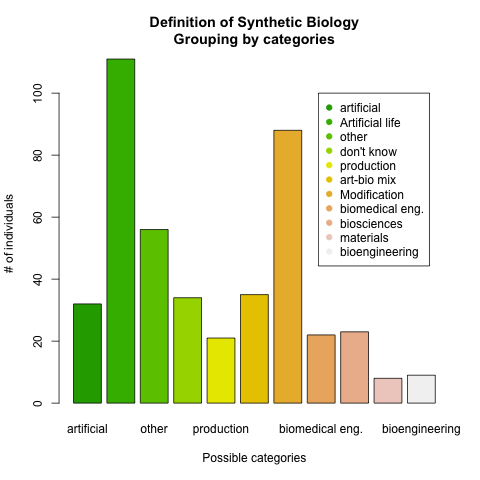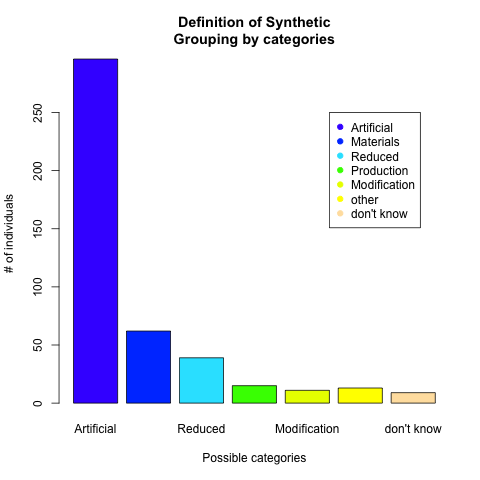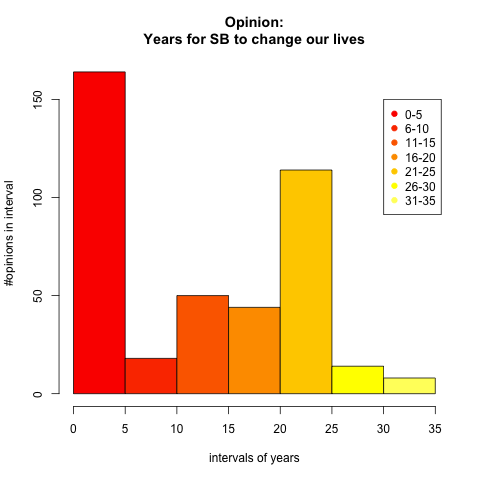Team:UNAM-Genomics Mexico/Safety
From 2010.igem.org
| Line 138: | Line 138: | ||
image:UNAM-Genomics_Mexico_Years_for_sb_change.png|Years until SB changes your World | image:UNAM-Genomics_Mexico_Years_for_sb_change.png|Years until SB changes your World | ||
</gallery> | </gallery> | ||
| + | |||
| + | The raw data will be available here. | ||
| + | |||
| + | For more information about what we did, or why we did it, please select an option in the dropdown menu below. | ||
| + | |||
| + | <html> | ||
| + | <form name="dropmsgform"> | ||
| + | <select name="dropmsgoption" size="1" style="width:300" onChange="expandone()"> | ||
| + | <option selected>Background</option> | ||
| + | <option>Survey 1</option> | ||
| + | <option>Survey 2</option> | ||
| + | </select> | ||
| + | <br> | ||
| + | |||
| + | |||
| + | <div id="dropmsg0" class="dropcontent"> | ||
| + | </html> | ||
| + | |||
| + | ====Human Practice section: The Synthetic Conquest of Mexico.==== | ||
| + | |||
| + | Objective.- Create a solid opinion about synthetic biology in Mexico, so that it can be exploited best for the country's needs. | ||
| + | |||
| + | |||
| + | =====Communicate and Conquer===== | ||
| + | |||
| + | We will soon meet the time when the advance on Synthetic Biology (SB) will touch the everyday life of the world population, as has happened with other technologies on which nowadays we have an apparent dependence, like the internet. However, nobody warned us about the magnitude of the impact such technologies could have upon our society and our decisions. For synthetic biology, if it is desired to change people's lives, it becomes part of the revolution, as well as a responsibility, to: | ||
| + | |||
| + | * extend and diffuse its concept in practical terms for non-science-oriented people to deal with, | ||
| + | * achieve that individuals understand the concept, the potential benefits, and potential risks of SB, | ||
| + | * foment the creation of well founded individual opinions towards the topic. | ||
| + | |||
| + | These musts will be the objectives to follow in our human practice: The Synthetic Conquest of Mexico, Part I”. | ||
| + | |||
| + | |||
| + | =====Strategy===== | ||
| + | |||
| + | Since it was impossible to cover the whole range of individuals in Mexico in a statically representative way, we decided to address high school students from the central part of Mexico. High school is a key moment for decisions in life; a moment in which we are open to different conceptions for we have to chose ours. Informing the youth is the first seed in the strategy to inform entire families. | ||
| + | |||
| + | In order to set grounds for the completion of the Synthetic Conquest of Mexico, the strategy we designed consisted of three simple steps: | ||
| + | |||
| + | * evaluate what people understand from the SB concept as a first impression (survey 1) | ||
| + | * give a dynamic lecture on SB which can inform even people with no background in biology, with emphasis on: | ||
| + | ** how biology can be engineered | ||
| + | ** how biomachines could change our lives in the near future | ||
| + | ** evaluate what people understand from the SB concept after the talk and when they think it will start changing our lives (survey 2). | ||
| + | |||
| + | =====A '''practical''' definition for Synthetic biology===== | ||
| + | |||
| + | People of the general public might not care about restriction sites, PoPS and copy number of plasmids; instead, they might want to know a general and practical idea of the implications of engineering biology, which involves “using engineering principles to assemble parts into biomachines in living organisms, to achieve a specific goal for human benefit”. Though we know this definition of synthetic biology is by no means representative of the whole field, it gives people a mental image which they can communicate to others and express their opinion about. | ||
| + | |||
| + | =====Hypothesis===== | ||
| + | |||
| + | If significantly more people get close to our “practical definition” of SB after the talk than before it, our talk is an effective mechanism to communicate the concept of SB (objective b described above). | ||
| + | |||
| + | <html> | ||
| + | </div> | ||
| + | <div id="dropmsg1" class="dropcontent"> | ||
| + | </html> | ||
| + | |||
| + | ====Survey 1==== | ||
| + | |||
| + | =====What does Survey 1 evaluate?===== | ||
| + | |||
| + | Survey 1, or the preliminary survey, is based on 4 questions: | ||
| + | |||
| + | * What do you understand by “synthetic”? | ||
| + | Question 1 sets the ground for the concept, since the understanding of the term “synthetic” will significantly influence the concept of SB. Expected categories are “artificial/manmade, summarized, or related to materials, like plastic. | ||
| + | |||
| + | * What do you think Synthetic Biology is? | ||
| + | Question 2 asks directly for the concept. A bit unexpected, this question challenges the survey taker to merge life with synthetic. Here we don't have many expectations, perhaps except for artificial life. This question will be directly compared to Question 1 from Survey 2. | ||
| + | |||
| + | * Do you think it is possible to transform a living being (i.e. Bacterium) in a “biomachine” to solve human problems? | ||
| + | This question, without directly referring to synthetic biology, encounters the reader with the advance being made in the field and a direct application of it. It lets us know about previous information the taker may have about general biotechnology. | ||
| + | |||
| + | * What kinds of problems do you think that could be solved? | ||
| + | This question makes the taker think about human needs or problems that haven't been successfully addressed by now. Prioritization of “needs” gives us information about the personal need of the individual; namely, it is important to draw a line between the first need an the second one, more carefully thought about. It also lets us know about the future acceptance of SB by the individual given that the problem solved is related to his view of a “need” (therefore, main fields of opportunity for SB). | ||
| + | |||
| + | |||
| + | =====Assumptions in Survey 1===== | ||
| + | |||
| + | * The reader will start from the first question downward. | ||
| + | * There is no influence from surrounding takers. | ||
| + | * The answers reflect a permanent point of view of the taker.(i.e. Not influenced by mood or other external factors) | ||
| + | * The survey is unbiased since the taker doesn't have choices to select from. | ||
| + | |||
| + | <html> | ||
| + | </div> | ||
| + | <div id="dropmsg2" class="dropcontent"> | ||
| + | </html> | ||
| + | |||
| + | ====Survey 2==== | ||
| + | |||
| + | =====What does survey 2 evaluate?===== | ||
| + | |||
| + | It evaluates the final conception and opinion about SB and the talk It will help usknow whether our talk was helpful in providing a working definition for SB to the audience. | ||
| + | |||
| + | Survey 2 is based on four questions: | ||
| + | |||
| + | * What did you understand by synthetic biology? | ||
| + | * Select the option that best suits your vision about engineering living organisms. | ||
| + | ** Nowadays it is possible to engineer living organisms | ||
| + | ** Nowadays it is not possible to engineer living organisms | ||
| + | ** other | ||
| + | * Do you think synthetic biology will change our lives in the upcoming years? | ||
| + | ** Yes, in ___ years. | ||
| + | ** No. | ||
| + | * Do you support the advancement of synthetic biology? Mention your opinion with positive and/or negative points. | ||
| + | * Write down any comments you have about the lecture or topic. | ||
| + | |||
| + | |||
| + | =====Assumptions in survey 2===== | ||
| + | |||
| + | <html> | ||
| + | </div> | ||
| + | |||
| + | </form> | ||
| + | </html> | ||
| + | |||
=='''Links'''== | =='''Links'''== | ||
Revision as of 19:30, 27 October 2010

Safety
Identifying Safety Issues
Probability
Could there be an unplanned event or series of events involving your project, resulting in either death, injury, occupational illness, damage to equipment or property, or damage to the environment? How likely is that going to happen?
There could always be some sinister series of unfortunate events that leads to disaster, however given the nature of our project, we believe that that little beyond minimal environmental exposure is the scope of catastrophe. Our BioBricks parts are mainly enzymes. These enzymes catalyze reactions that are already found in nature in a wide variety of environmental niches. As such, they are nothing new. Nature has found ways of balancing their actions, so even if they were to be exposed dramatically, the perturbation should be minimal and easily self-correcting.
Does your project require the exposure or release of the engineered organism to people or the environment (e.g. as medicine, for bioremediation)?
Our project does not require exposure or release to either people or environment. In fact, this project is meant to be tested under extreme biological, chemical and even thermal isolation. One of the points we want to prove is the fact that we can communicate information where there is no possible biological, chemical or even thermal bridge spanning our communicating entities. They will be isolated, both from each other as from the environment.
Hazard
Could your device, when working properly, represent a hazard to people or the environment?
We do not believe our device represents a hazard. If working properly, our devices will stress the host organism without generating any short-term benefit. As such, they are only an added metabolic process to the host. At most, our devices would generate a higher-than-average amount of reactive oxygen species, but not in a significant manner. Perhaps, should the reactions be extreme in number, the light emission could be a hazard to the naked eye...
Is your engineered organism infectious? Does it produce a toxic product? Does it interfere with human physiology or the environment?
Our engineered organism is not infectious, nor does it produce toxic products. The only dangerous product of our devices are reactive oxygen species, however their net production is not significant. Moreover, human physiology (as well as most other physiologies to our knowledge) is quite capable of dealing with reactive oxygen species so long they do not exceed a certain threshold.
What would happen if one or several bioparts change their function or stop working as intended (e.g. through mutation)? How would the whole device or system change its properties and what unintended effects would result thereof?
Mutation of our BioBrick parts would most likely result in loss of function. Thus, our organisms would either go blind, or stop glowing. Should the extraordinary happen and gain of function occur, we fathom our organisms would be over-taxed and they would die. Since our parts are only a net drag on the survivability of our organisms, it would require some extreme mutations to render them a selective advantage for the host. However, this risk exists for any exogenous protein in a host.
What unintended effects could you foresee after your engineered organism is released to the environment?
We can foresee the spread of the BioBrick parts through the environmental bacterial populations via horizontal gene transfer. However, since the bearing plasmid only holds a selective advantage under antibiotic conditions, we expect it to be quickly lost. Moreover, in the event our devices escape the original plasmid and hop into another structure, light communication holds no selective advantage in and of itself within current free-living populations of E. coli. Thus we feel confident our devices would over-tax their hosts and ensure death.
Try to think outside the box, what is the absolut worst case scenario for human health or the environment, that you could imagine?
The Absolute Worst Case Scenario? As if in a movie by Micheal Bay? Well...
We can image our E. colis forming a structure much like a neural network to process information as a colony instead of as a single cell. Under quite permissive conditions, they might gain a selective advantage by operating in a multi-cellular organization. If grown to 1.2 optical density in a 1 liter beaker, they may very well have more connections than a human brain. Given sufficient time, they might learn to think as a collective. Should they develop proteins that receive wavelengths of around 1mm, they might tune into Radio & Television. Thus, they might learn of and imitate the Borg Collective, posing a danger to Human supremacy of the Planet!!!
Seriously though, due to the chassis mutations required by our system, either the bacteria are producing non-stop tryptophan (which constitutes a tremendous metabolic stress), or they can not adjust osmolarity (which makes them utterly incompetent in the outside world). Morevoer, for them to sense in more than one color, both mutations need to be present, which makes the bacteria even less competent. One way or another, these cells need careful human attention to survive. Thus can the be easily controlled.
Documentation & Management of Safety Issues
Parts
Current
Work in progress.
Emergent
Work in progress.
Devices & Systems
Current
Work in progress.
Emergent
Work in progress.
Cell Chassis Enhancement
Current
Work in progress.
Emergent
Work in progress.
BioSafety Engineering
Event Tree Analysis
Coming Soon (hopefully).
Fault Tree Analysis
Coming Soon (hopefully).
Public Perception
Human Practices
These are the results for our Human Practices activities.
The raw data will be available here.
For more information about what we did, or why we did it, please select an option in the dropdown menu below.
Links
The iGEM Safety page is this one: safety page.Contents |
iGEM
iGEM is the International Genetically Engineered Machines Competition, held each year at MIT and organized with support of the Parts Registry. See more here.Synthetic Biology
This is defined as attempting to manipulate living objects as if they were man-made machines, specifically in terms of genetic engineering. See more here.Genomics
We are students on the Genomic Sciences program at the Center for Genomic Sciences of the National Autonomous University of Mexico, campus Morelos. See more here.This site is best viewed with a Webkit based Browser (eg: Google's Chrome, Apple's Safari),
Trident based (Microsoft's Internet Explorer) or Presto based (Opera) are not currently supported. Sorry.
 "
"
